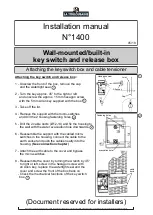
11-1
v1.0, June 2010
Chapter
11
Differentiated Services
In this chapter, the following examples are provided:
•
“Differentiated Services” on page
11-2
•
“DiffServ for VoIP Configuration” on page
11-20
•
“Auto VoIP Configuration” on page
11-29
•
“DiffServ for IPv6 Configuration Example” on page
11-33
•
“Color Conform Policy Configuration” on page
11-41
Differentiated Services (DiffServ) is one technique for implementing Quality of Service (QoS) policies.
Using DiffServ in your network allows you to directly configure the relevant parameters on the switches and
routers rather than using a resource reservation protocol.This section explains how to configure the 7000
Series Managed Switch to identify which traffic class a packet belongs to, and how it should be handled to
provide the desired quality of service. As implemented on the 7000 Series Managed Switch, DiffServ allows
you to control what traffic is accepted and what traffic is discarded.
How you configure DiffServ support on a 7000 Series Managed Switch varies depending on the role of the
switch in your network:
•
Edge device.
An edge device handles ingress traffic, flowing towards the core of the network, and
egress traffic, flowing away from the core. An edge device segregates inbound traffic into a small set of
traffic classes, and is responsible for determining a packet’s classification. Classification is primarily
based on the contents of the Layer 3 and Layer 4 headers, and is recorded in the Differentiated Services
Code Point (DSCP) added to a packet’s IP header.
•
Interior node.
A switch in the core of the network is responsible for forwarding packets, rather than for
classifying them. It decodes the DSCP code point in an incoming packet, and provides buffering and
forwarding services using the appropriate queue management algorithms.
Before configuring DiffServ on a particular 7000 Series Managed Switch, you must determine the QoS
requirements for the network as a whole. The requirements are expressed in terms of rules, which are used to
classify inbound traffic on a particular interface. The switch software does not support DiffServ in the
outbound direction.
Rules are defined in terms of classes, policies and services:
•
Class.
A class consists of a set of rules that identify which packets belong to the class. Inbound traffic is
separated into traffic classes based on Layer 3 and 4 header data and the VLAN ID, and marked with a
corresponding DSCP value. One type of class is supported:
All,
which specifies that every match
criterion defined for the class must be true for a match to occur.
















































